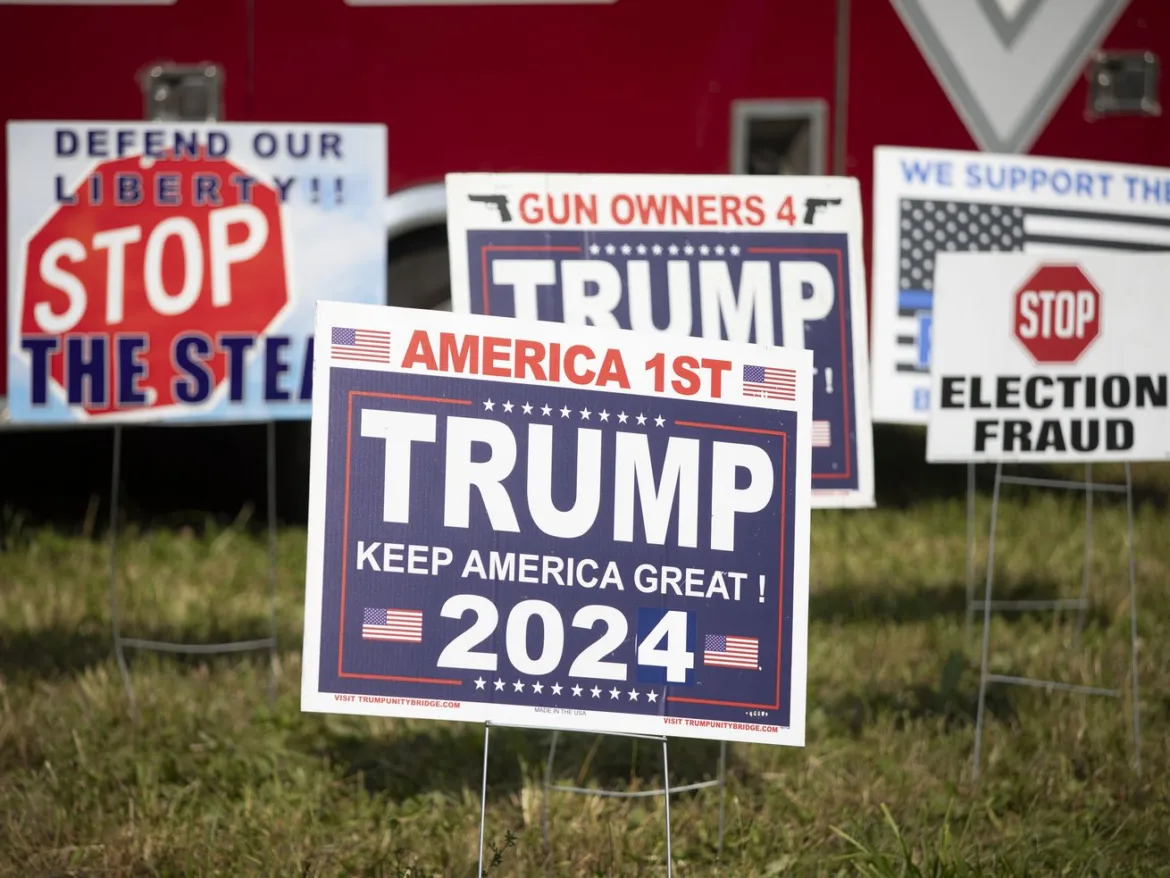What the debate over “white rural rage” misses.
White rural Americans are a “racist, xenophobic, anti-immigrant, anti-gay” authoritarian fifth column that poses an existential threat to our republic.
Unless they are actually a downtrodden people who rightly resent the condescension of liberal elites and wish for little more than “to preserve a sense of agency over their future and a continuity of their community’s values and social structures.”
These are the twin poles of blue America’s current debate over why rural white folks vote the way they do.
This argument is as old as the urban-rural divide itself. But the latest round was triggered by White Rural Rage: The Threat to American Democracy, a bestselling book from the political scientist Tom Schaller and journalist Paul Waldman.
Schaller and Waldman argue that rural white voters are exceptionally reactionary, racist, and anti-democratic. In their telling, these retrograde impulses turn this group into easy prey for a Republican Party that shutters rural hospitals, denies workers’ health insurance, erodes labor rights — and then says, in so many words, let them eat hate.
Many commentators and political scientists have taken exception to this argument. The Atlantic’s Tyler Austin Harper argues that White Rural Rage “illustrates how willing many members of the U.S. media and the public are to believe, and ultimately launder, abusive accusations against an economically disadvantaged group of people that would provoke sympathy if its members had different skin color and voting habits.”
In his account, the real threat to American democracy “is not white rural rage, but white urban and suburban rage” — a fact that would be plain to Waldman and Schaller, Harper says, if they’d only paid more careful attention to the studies their book cites.
Colby College political scientist Nicholas Jacobs, meanwhile, insists that White Rural Rage’s “simplistic” and inaccurate thesis amounts to little more than “an outpouring of frustration with rural America that might feel cathartic for liberals, but will only serve to further marginalize and demonize a segment of the American population that already feels forgotten and dismissed by the experts and elites.”
In my view, this debate has gotten a bit muddled, with each side dancing around inconvenient facts. The argument between White Rural Rage’s champions and its critics would generate more light (and perhaps less heat) if all involved grappled with five important truths:
1) Rural white people are more supportive of right-wing authoritarianism than are urban or suburban ones
Harper’s central claim — that rural white people actually pose less of a threat to American democracy than urban and suburban ones — rests on faulty reasoning.
His case can be boiled down into three points:
- A 2021 paper in Journal of Democracy found that “political violence” in the US “has been greatest in suburbs where Asian American and Hispanic American immigration has been growing fastest.”
- Several high-profile right-wing extremists, including the “pizzagate” gunman, came from areas that aren’t rural, at least by certain definitions of that term.
- The vast majority of Americans who believe that the 2020 election was stolen — and that Trump would therefore be justified in reclaiming the presidency by force — live in urban areas.
These facts establish that white rural Americans are not uniquely right-wing or authoritarian; supporters of Trump and the January 6 Capitol riot can be found in nearly every category of municipality. Harper is right to object to the singling out of white rural voters writ large, when the problem is illiberal reactionaries in every part of the country.
Nonetheless, his evidence doesn’t contradict the premise that rural white people are unusually supportive of Donald Trump and January 6.
This is a fatal problem for his argument, since Trump is the fundamental threat to American democracy today. All political violence is lamentable, but individual militants cannot undermine the independence of federal law enforcement, the integrity of the electoral process, or the peaceful transfer of power; an insurrectionary president plausibly can.
And there is no question that white voters from low-density areas support Trump by much larger margins than their counterparts in high-density places.
In the 2020 election, rural white voters backed Trump over Biden by 42 points, while suburban white voters favored him by just 7, according to the Democratic data firm Catalist. Urban white voters, meanwhile, supported Biden over Trump by a 32-point margin.
If rural white Americans voted the same way that suburban white Americans do, then Trump would never have been elected president and his brand of authoritarianism would not be competitive in national elections. If all white Americans voted like those who live in cities, meanwhile, then Trump’s party would have negligible influence over the federal government.
What’s more, Harper acknowledges that rural white Americans are “overrepresented” among those who support restoring Trump to power by force.
Given these facts, it’s silly to argue that urban and suburban white people are doing more to imperil American democracy than their rural counterparts. Harper’s only real counter is that more supporters of January 6 live in cities than in rural areas. But this is a trivial point: Roughly 80 percent of Americans live in non-rural areas. Name any ideological group under the sun and you’re almost certain to find that a majority of that group lives in high-population municipalities, rather than in places that, by definition, have few people.
2) Millions of rural white Americans support the Democratic Party
All this said, rural white voters are not a monolith. In fact, such voters were an indispensable part of Biden’s 2020 coalition.
Yes, the president won only 28 percent of that voting bloc, but that adds up to more than 9 million votes. In 2020, Biden won nationally by roughly 7 million ballots and took many swing states by tiny margins. Subtract all rural white Democrats from Biden’s column and Trump almost certainly would have won reelection.
Waldman and Schaller’s rhetoric does a disservice to this small but significant segment of the public, which has held the line against Trumpism in places where doing so entails significant social penalties and risks.
More importantly — as Harper and Jacobs emphasize — demonizing white rural voters is a luxury that urban liberals can scarcely afford. Yes, the median white voter in rural America is never going to support Biden. But rural white swing voters exist. And in a close election, even a small reduction or increase in Biden’s share of that bloc could prove decisive.
3) Rural white Republicans are not New Deal Democrats who got confused
Liberals and leftists have long debated the root causes of rural America’s support for the Republican Party. Some point to the fact that rural white Americans supported the New Deal and conclude that many in the demographic would back Democrats again today if only the party offered more ambitious economic reforms. Others argue that rural white people are simply too racist to support a minimally progressive political party.
By my lights, it is unwise to base your theory of American political behavior in 2024 on voting patterns in 1932. A lot has happened in the last 92 years. When FDR was first elected,
- 43 percent of Americans lived in rural areas
- the entire South was controlled by a white supremacist faction that was briefly, improbably tethered to a coalition with northern liberals
- the unemployment rate was stuck above 20 percent
- personal income per capita in the US was roughly one-seventh as high as it is today
- the sexual revolution had not yet occurred
- conservative mass media barely existed, and
- there was, more or less, no federal welfare state.
There is no reason in principle to assume that rural voters’ political priorities and inclinations have not changed along with their country.
As Schaller and Waldman demonstrate, the argument that many rural white people are motivated by racial resentments is significantly more robust.
But, as Nicholas Jacobs suggests, it is almost certainly true that not all white rural Republicans are motivated by racism. Yet Jacobs’s essay for Politico dances around the other primary explanation for rural white support for Trump: They simply have many conservative beliefs and policy preferences.
After all, rural voters are more conservative than urban ones in virtually every developed country, including those where race plays a smaller role in politics than it does in America.
You don’t need to be racist to believe a fetus is a person. And rural Americans are disproportionately supportive of abortion restrictions, which likely influences their partisan preferences. Many rural areas also depend on extractive, carbon-intensive industries for economic growth. Likely as a result, rural Americans are less supportive of climate action than urban or suburban ones, even when controlling for partisanship and demographics.
Jacobs suggests that rural Americans’ opposition to liberal immigration policies is rooted less in racism than a desire to preserve their sense of “place.” This premise is debatable, at best. Yet Jacobs doesn’t merely wish to argue that rural Americans’ desire for community preservation has little to do with racism but also that it has little to do with conservatism:
Taken as a whole, rural voters are not merely reacting against change — be it demographic or economic. They are actively seeking to preserve a sense of agency over their future and a continuity of their community’s values and social structures. Some might call this conservatism, but I think it is the same thing motivating fears of gentrification in urban areas, or the desire to “keep Portland weird.”
It is true that rural Americans aren’t the only ones who try to protect their communities from outsiders and cultural change. Urban and suburban liberals do this through housing policies that make their municipalities less affordable for newcomers, while rural conservatives do it by supporting anti-immigration politicians. In both cases, the political impulse driving voter behavior is a conservative one: Prizing stasis over change and insiders over outsiders is, more or less, the antithesis of progressivism, properly understood.
4) The economic challenges facing many rural areas are inherently difficult to solve.
Both sides in the White Rural Rage debate agree that Democrats have done more to help rural America materially than Republicans have. In addition to saving many rural hospitals with Medicaid expansion, Democrats have also directed a disproportionate share of federal job creation dollars toward low-density areas.
But Jacobs emphasizes that these are inadequate to address rural areas’ problems. Such communities often suffer from limited employment opportunities, fiscal shortfalls, and teacher shortages — all of which are partly a function of falling populations.
Yet the causes of rural America’s depopulation are structural. High-population areas inherently offer greater opportunities for workers to specialize and complement each other’s labor. This translates into higher productivity, which generally translates into higher wages. It would take an enormous amount of social engineering to stop ambitious young people born into declining rural areas from migrating to cities and suburbs. Making rural life sufficiently appealing to retain around 20 percent of the US population already requires massive subsidization of inefficient rural infrastructure and health care systems.
Given that rural ways of life are also more carbon intensive than high-density living, attempting to engineer an increase in the rural population through social policy seems ill-advised. Meanwhile, many important policy initiatives — such as increasing housing abundance in thriving metro centers — would likely have the side effect of accelerating rural depopulation.
One measure that plausibly could arrest the decline of many economically depressed rural communities would be place-based immigration policies, which offer visas to immigrants willing to work in low-density areas. But this is the exact opposite of what rural white voters are demanding from their representatives.
There is a lot more that Democrats can do to help working-class people writ large. But the party lacks a great, politically viable answer for reviving shrinking rural communities because there isn’t one.
5) Most people inherit the politics of their families and communities
Finally, however one interprets the politics of white rural America, I think it’s a mistake to treat ordinary Trump voters with contempt or as bad human beings by definition. (I don’t think Waldman and Schaller necessarily do this, but some on their side of the argument do.)
In Salon, Amanda Marcotte applauds White Rural Rage for treating its subjects as “functioning adults who have agency” and not “the childlike ciphers of Fox News.” This is an understandable sentiment. Marcotte is herself a product of white rural America who rejected the reactionary politics of her parents. Her impatience with apologias for Trump supporters in “the Heartland” — which often attribute their lamentable voting behavior to everything but their own failures of good citizenship — is well-founded.
At the same time, Marcotte is an exception from the general rule: Most voters inherit the politics of the families and communities they were born into. According to a 2023 Pew survey, more than 80 percent of American teens support the same political party as their parents.
I believe that my politics are more moral than those of a Trump voter, but I don’t think that says much about my moral character. I was born to liberal parents in a left-leaning suburb of a blue state. If I’d grown up in a rural town where everyone I knew and loved believed that Democrats were the Godless servants of corrupt elites and shiftless poor people, then I’d probably have voted for Trump; the data admits no other conclusion.
Awareness of how thoroughly accidents of birth and experience shape our selves and life outcomes should make us more supportive of income redistribution and more opposed to retributive criminal justice policies. But it should also make us a bit more patient with Trump voters.
This does not mean that liberals shouldn’t harshly criticize reactionary beliefs or candidates. But we should hate the vote, not the voter. Rage is rarely the most politically productive emotion — whether it’s of the “white rural” or urban liberal variety.



